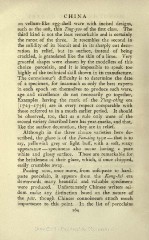Page 326 - Oriental Series Japan and China, Brinkly
P. 326
CHINA
on vellum-like egg-shell ware with incised designs,
such as the soft, thin Ting-yao of the first class. The
third kind is not the least remarkable and is certainly
the rarest of the three. It resembles the second in
the solidity of its biscuit and in its sharply cut deco-
ration in relief, but its surface, instead of being
crackled, is granulated like the skin of a lime. Very
graceful shapes were chosen by the modellers of this
choice porcelain, and it is impossible to speak too
highly of the technical skill shown in its manufacture.
The connoisseur's difficulty is to determine the date
of a specimen, for inasmuch as only the best experts
in each epoch set themselves to produce such ware,
age and excellence do not necessarily go together,
Examples having the mark of the Yung-ching era
(17231736) are in every respect comparable with
those referred to in a much earlier period. It should
be observed, too, that as a rule only ware of the
second variety described here has year-marks, and that,
like the surface decoration, they are in relief.
Although in the three choice varieties here de-
scribed, the glaze is of the Fan-ting type that is to
say, yellowish grey or light buff, with a soft, waxy
appearance specimens also occur having a pure
white and glossy surface. These are remarkable for
the brittleness of their glaze, which, if once chipped,
easily crumbles away.
Passing now, once more, from soft-paste to hard-
paste porcelain, it appears from the Kang-hsi era
downwards many beautiful and valuable specimens
were produced. Unfortunately Chinese writers sel-
dom make any distinction based on the nature of
the pate, though Chinese connoisseurs attach much
importance to this point. In the list of porcelains
264

